
Print the PDF version (no pictures, better printing)


source
Autumn’s changes in leaf colors are most striking on campus. This is a consequence of the changing levels of photosynthetic pigments within the leaves. For example, the decline in chlorophyll within the leaves results in the appearance of more orange and red hues, revealing pigments that had been “masked” by higher levels of chlorophyll all summer long. The pigment carotene funnels energy to special chlorophyll molecules, causing chlorophyll electrons to be kicked into an electron transport chain.
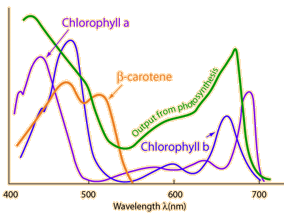 source
sourceOklahoma agriculture is famed for its production of winter wheat: This crop is planted in the autumn, sprouts but stays dormant during the winter. Then the young plant grows in spring and is harvested in early summer. In addition to bread production, wheat also provides a supplemental primary producer food source for livestock. The starch produced by wheat and other plants consists of glucose molecules joined together. Starch is broken down into glucose molecules during digestion with the aid of enzymes in the stomach and intestines. Cellulose molecules also consist of glucose molecules joined together in a different manner. Unlike starch, cellulose is indigestible by people and is the primary material in the wood and bark of trees. An Oklahoma wheat plant produces and stores a considerable amount of starch. Thus, not surprisingly, a major source of starch in our diet is bread.
 source
source
source

source
Plants also produce protein. Each plant protein consists of chains of amino acids (generic structure shown to the left).

source
Microbiologists are growing a pathogenic (disease-causing) bacterium in a rich liquid culture flask. The table above records the numbers of living bacteria within a flask with abundant growth media. After the bacteria were allowed to grow for an extended period of time, the following figure was generated to describe growth.
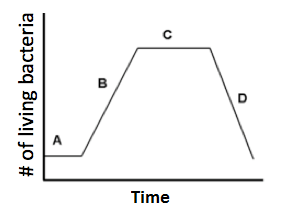
TIME: (# hrs within flask) |
1 |
2 |
3 |
4 |
5 |
# living bacteria in flask |
750 |
1,500 |
3,000 |
6,000 |
12,000 |

source
Black widow spiders frequently live around houses. Their bite is painful and it transfers latrotoxin to the victim, which causes a massive release of neurotransmitters. If bitten, you should seek medical attention immediately. Approximately 1% of those bitten will die without medical help. Black widows are predators and tend to eat insects, such as grasshoppers. Grasshoppers are primary consumers.
Black widow spiders have a red spot shaped like an hour-glass on their abdomens. As the spider sits in the sun, its black color helps it warm up quickly.
Black widow spiders are commonly found in wood piles. 10 spiders migrated to a new woodpile that initially had unlimited resources.

source
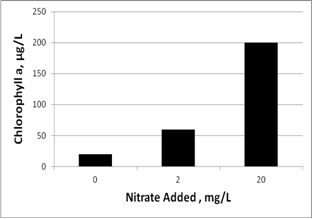
A scientist was evaluating how the addition of nitrate influences algae growth in a pond. She collected three water samples from the pond. To the first control sample she did not add additional nitrate (although some nitrate was already in the water), to the second she added 2 mg/L of extra nitrate, and to the third sample she added 20 mg/L of extra nitrate. She incubated all the samples in sunlight for one week and then measured the chlorophyll a as an indicator of the algae population.
Following the initial experiment, the scientist seals the samples inside of jars and turns off the lights.![]() Hippopotami, despite their massive normal size, can suffer from obesity, relatively speaking. Zookeepers conducted some genetic tests on some inhabitants of their hippo pool and partially completed the following data table:
Hippopotami, despite their massive normal size, can suffer from obesity, relatively speaking. Zookeepers conducted some genetic tests on some inhabitants of their hippo pool and partially completed the following data table:
Hippo |
Sex |
Leptin produced |
|
Phenotypes |
Genotypes |
|
Hamlet |
Male |
N |
Y |
Heavy |
oo; Dd; DD |
|
Horatio |
Male |
Y |
N |
|
|
|
Helena |
Female |
N |
N |
|
oo; dd |
|
Hermia |
Female |
Y |
Y |
Normal |
|
Hippos love the water, especially on a hot day when the sun is especially bright. Hippos also eat aquatic plants.
 source
sourceNPY (neuropeptide Y) is a small protein that stimulates the appetite when it is secreted into the blood. Leptin hormone also acts as an appetite suppressant by blocking transcription of the gene coding for NPY. In the middle of the neuropeptide Y protein is a sequence of amino acids: serine, proline, glycine.
 source
source
source
Orcas (killer whales) are much larger than hippos and spend their lives in much colder water. While their bodies are encased in lots of blubber (fat) that insulates them, their dorsal fins are relatively thin.

source
On rare occasions you can find pink katydids. This phenotype is caused by erythrism, where an individual has an exceptional amount of red pigmentation. The allele that causes erythrism is autosomal and recessive. Male katydids attract females by singing. Making these mating songs requires energy for the male katydids to move their muscles.
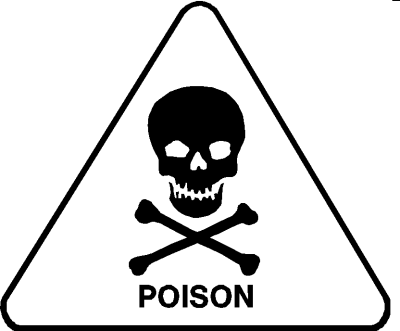
source
One fish is poisoned with cyanide, a compound that interferes with one of the electron acceptors in the electron transport chain in the mitochondria. A second fish is poisoned with dinitrophenol, which makes the inner membrane of the mitochondria leaky.
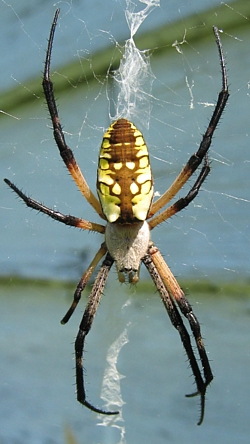
source
According to the fossil record, spiders arose about 400 million years ago during the Devonian Period. They are generalist predators, with most species consuming a wide variety of insects. Spiders that weave an orb shaped web are believed to have originated about 200 million years ago during the Triassic Period and then underwent rapid diversification (many new species arose in a relatively short period of time). Orb shaped webs are very difficult to construct but are very flexible and resistant. And at least one recent study suggests that all orb weaver spiders currently in existence originated from a single species of spider.

source
Tuberculosis kills over 2 million people in the world each year. It is caused by the bacterium known as Mycobacterium tuberculosis. This bacterium cannot survive outside of a human (or occasionally an animal) host for more than a few hours. Recently, scientists have discovered that these bacteria are able to make a protein called PtpA that protects them from being killed after they have been taken up by the human host macrophage by phagocytosis.

source
Tuberculosis is uncommon in the United States but does occur on a limited basis in prisons. Multiple antibiotic resistant Mycobacterium tuberculosis bacteria are often found among infected prison inmates.

source